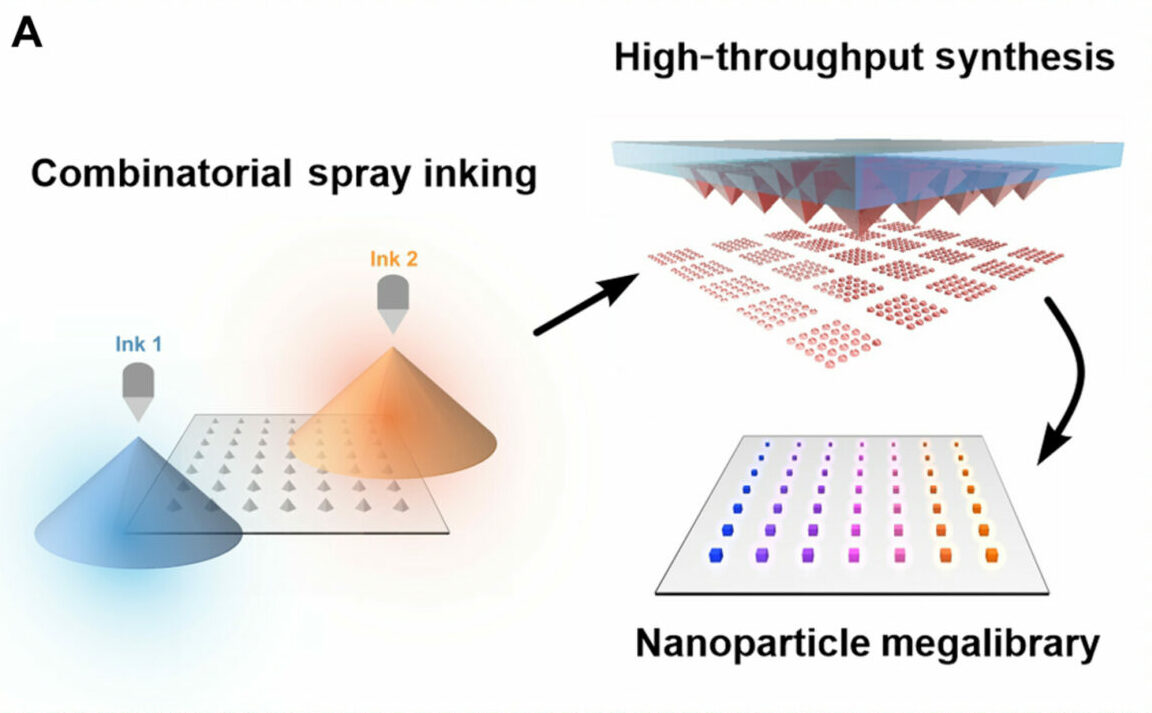Nanotechnology at Northwestern, News
Accelerating the Discovery of Materials that Pave a New Path to Energy-Efficient White Light Emission
January 22, 2025

The International Institute for Nanotechnology (IIN) at Northwestern University (NU) is excited to announce new research led by Chad Mirkin, Director of the IIN, and George B. Rathmann, Professor of Chemistry, that may pave the way for a new era in energy-efficient lighting. Mirkin’s paper, “Creating Chromaticity Palettes and Identifying White Light Emitters through Nanocrystal Megalibraries,” was recently published in Science Advances. This pioneering work tackles global energy and environmental challenges posed by traditional lighting technologies, which account for 15-20% of global electricity use and 5% of greenhouse gas emissions.
Challenges and Breakthroughs in Lighting Technology
While white light-emitting diodes (WLEDs) have transformed the lighting industry with their high efficiencies and long lifespans, current designs often rely on complex, multi-layered systems. These systems are costly, challenging to fabricate, and prone to instability due to differences in the materials’ response to fatigue and resistance to heat and light. The result? Higher production costs and reduced long-term performance.
Enter the chromaticity palette, a new tool introduced by Mirkin and his team and first used by them to accelerate the discovery of single-composition white light emitters. Using megalibraries of Mn²⁺-doped perovskite nanocrystals as a proof-of-concept, the researchers systematically mapped the compositional space of gradients of these materials to identify those whose capacity to emit white light is enhanced. The nanocrystal materials discovered through this process could replace the multi-layer structures that are traditionally used, simplifying WLED design and addressing significant issues related to cost and stability.
“Chromaticity palettes and megalibraries may become game-changers,” said Ted Sargent, Executive Director, Paula M. Trienens Institute for Sustainability and Energy. “They allow us to rapidly make and identify materials with tailored optical properties, opening up a world of possibilities for energy-efficient and cost-effective lighting solutions.“
The single-composition white light emitters discovered by the NU researchers are poised to dramatically change the lighting industry again. They promise more stable, energy-efficient, and cost-effective WLEDs, reducing global electricity consumption and lowering carbon emissions. The scalability of this system also means that the transition from lab to industrial production is within reach, so this innovation could offer immediate and tangible benefits.
Indeed, in addition to Mn-based perovskites, the concept of chromaticity palettes can be used to investigate other materials like Pd-free perovskites, quantum dots, metal oxides, and transition metal dichalcogenides. This versatility opens doors to customized materials with specialized optoelectronic, chiroptical, and magneto-optical properties, addressing current, pressing industry challenges.
The Transformative Power of Megalibraries and AI
At the heart of this discovery lies the concept of megalibraries— millions of positionally encoded nanomaterials synthesized on a chip no larger than a postage stamp. These libraries created using cutting-edge techniques like evaporation crystallization–polymer pen lithography (EC-PPL), also invented by Mirkin and his team, allow researchers to prepare and then screen millions, or in some cases, even billions, of material compositions in a fraction of the time required by traditional methods. By enabling the systematic exploration of vast compositional spaces, megalibraries have redefined what is possible in materials discovery, providing the foundation for rapid advances in optoelectronics.
Integrating megalibraries with artificial intelligence (AI) and machine learning (ML) further amplifies their impact. The massive datasets generated from megalibraries enable AI-driven analysis, and the researcher can uncover complex and non-intuitive relationships between material composition, structure, and properties. This data-driven approach accelerates the discovery and optimization of materials with unparalleled speed and precision. As AI and ML continue to evolve, their synergy with megalibraries is expected to revolutionize the field of material informatics, driving innovation across industries. AI-driven material discovery with megalibraries has already significantly impacted the clean energy industry.
“Megalibraries, when combined with AI, empower us to tackle challenges that once seemed insurmountable,” Mirkin noted. “The ability to rapidly gather and analyze vast amounts of high-quality materials data, use it train ML algorithms, and ultimately engage in inverse materials design loops will fundamentally transform how we approach material discovery for a variety of purposes.”
Mattiq, a company based upon research initiated in Mirkin’s lab at Northwestern, and Toyota exemplify how megalibraries and AI are transforming material discovery. Mattiq’s ‘chemistry for climate’ platform integrates nanotechnology and AI to accelerate the development of new materials for the energy transition. By synthesizing and evaluating millions of potential combinations in parallel, Mattiq streamlines the historically fragmented process of creating novel materials, generating vast amounts of high-quality data to fuel AI models that predict and optimize material performance. Similarly, Toyota leverages megalibraries and AI to design lightweight, high-strength materials and improve hydrogen fuel cells, paving the way for more efficient electric vehicles and sustainable automotive manufacturing. Together, these applications highlight the growing role of megalibraries and AI in addressing industrial challenges and shaping the future of clean energy and transportation. (Additional information about Toyota and Mattiq’s work can be found here and here).
Lighting the Way Forward
This research highlights the potential of high throughput nanotechnology-based discovery processes to tackle energy and environmental challenges. By revolutionizing how materials are discovered, this approach accelerates the development of sustainable technologies that can address a wide range of industrial and societal needs. These advancements signify a new era in material science and engineering, and they will do for this field what the Human Genome Project did for biotechnology and medicine.
The IIN remains committed to pushing the boundaries of innovation using nanoscience and technology, a field that is a part of the fabric of all disciplines and that will remain pivotal in shaping a sustainable and efficient future for all.
Creating Chromaticity Palettes and Identifying White Light Emitters through Nanocrystal Megalibraries” was published in Science Advances on January 17.
About the International Institute for Nanotechnology
Founded in 2000 as an umbrella organization to coalesce and foster nanotechnology efforts globally, the International Institute for Nanotechnology, directed by Prof. Chad A. Mirkin, represents and unites more than $2.7 billion in nanotechnology research, educational programs, and supporting infrastructure.